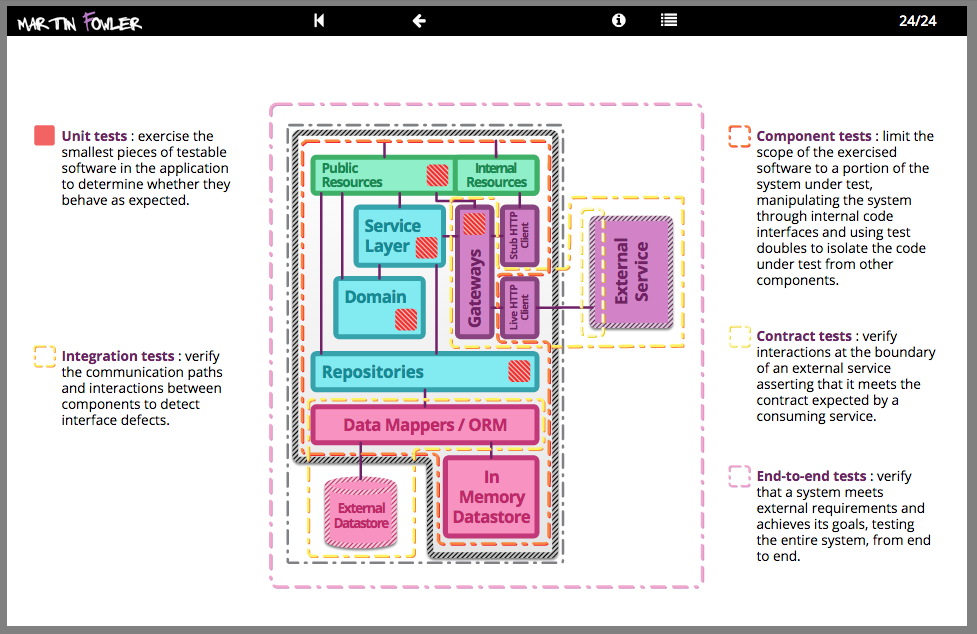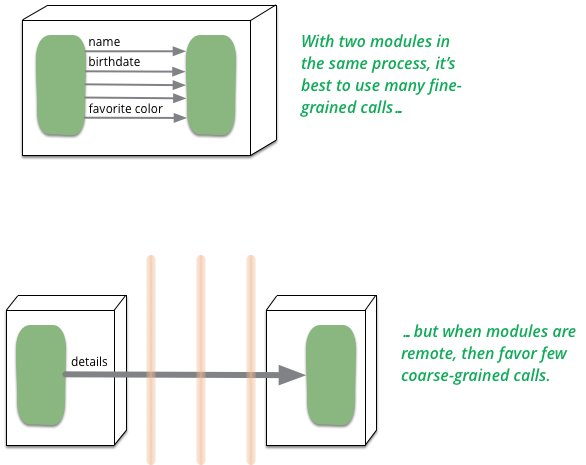tagged by: microservices
Microservices Guide

The microservice architectural pattern is an approach to developing a single application as a suite of small services, each running in its own process and communicating with lightweight mechanisms, often an HTTP resource API. These services are built around business capabilities and independently deployable by fully automated deployment machinery. There is a bare minimum of centralized management of these services, which may be written in different programming languages and use different data storage technologies. While their advantages have made them very fashionable in the last few years, they come with the costs of increasing distribution, weakened consistency and require maturity in operational management.
Microservices

The term “Microservice Architecture” has sprung up over the last few years to describe a particular way of designing software applications as suites of independently deployable services. While there is no precise definition of this architectural style, there are certain common characteristics around organization around business capability, automated deployment, intelligence in the endpoints, and decentralized control of languages and data.
Microservices Talk
As with any bit of new architectural terminology, it's hard to get a decent definition of what microservices are, so this talk kicks off by tackling that, based on the article by James and I that helped fuel the interest. I then compare microservices to SOA, compare the architecture to a more monolithic approach, and outline important things you have to get right before you should deploy a microservice application.
How to break a Monolith into Microservices

As monolithic systems become too large to deal with, many enterprises are drawn to breaking them down into the microservices architectural style. It is a worthwhile journey, but not an easy one. We've learned that to do this well, we need to start with a simple service, but then draw out services that are based on vertical capabilities that are important to the business and subject to frequent change. These services should be large at first and preferably not dependent upon the remaining monolith. We should ensure that each step of migration represents an atomic improvement to the overall architecture.
Interview with Sam Newman about Microservices

goto conferences asked me to do an interview with Sam Newman on his book: “Monoliths to Microservices”. This turned into a general conversation about microservices and when to use them. Sam considers the three main reasons for them to be independent deployability, isolation of data, and reflecting the organizational structure. I'm more skeptical of the first, but consider data and people to be complicated parts of software development.
Catalog of Patterns of Distributed Systems

Distributed systems provide a particular challenge to program. They often require us to have multiple copies of data, which need to keep synchronized. Yet we cannot rely on processing nodes working reliably, and network delays can easily lead to inconsistencies. Despite this, many organizations rely on a range of core distributed software handling data storage, messaging, system management, and compute capability. These systems face common problems which they solve with similar solutions. In 2020 Unmesh Joshi began collecting these solutions as patterns, publishing them on this site as he developed them. In 2023 these were published in the book Patterns of Distributed Systems. This page links to short summaries of each pattern, with deep links to the relevant chapters for the online eBook publication on oreilly.com
How to extract a data-rich service from a monolith

When breaking monoliths into smaller services, the hardest part is actually breaking up the data that lives in the database of the monolith. To extract a data-rich service, it is useful to follow a series of steps which retain a single write-copy of the data at all times. The steps begin by making a logical separation in the existing monolith: splitting service behavior into a separate module, then separating data into a separate table. These elements can be separately moved into a new autonomous service.
Micro Frontends

Good frontend development is hard. Scaling frontend development so that many teams can work simultaneously on a large and complex product is even harder. In this article we'll describe a recent trend of breaking up frontend monoliths into many smaller, more manageable pieces, and how this architecture can increase the effectiveness and efficiency of teams working on frontend code. As well as talking about the various benefits and costs, we'll cover some of the implementation options that are available, and we'll dive deep into a full example application that demonstrates the technique.
Microservice Trade-Offs

Many development teams have found the microservices architectural style to be a superior approach to a monolithic architecture. But other teams have found them to be a productivity-sapping burden. Like any architectural style, microservices bring costs and benefits. To make a sensible choice you have to understand these and apply them to your specific context.
Testing Strategies in a Microservice Architecture

There has been a shift in service based architectures over the last few years towards smaller, more focussed “micro” services. There are many benefits with this approach such as the ability to independently deploy, scale and maintain each component and parallelize development across multiple teams. However, once these additional network partitions have been introduced, the testing strategies that applied for monolithic in process applications need to be reconsidered. Here, we plan to discuss a number of approaches for managing the additional testing complexity of multiple independently deployable components as well as how to have tests and the application remain correct despite having multiple teams each acting as guardians for different services.
Microservices and the First Law of Distributed Objects

In P of EAA I said "don't distribute your objects". Does this advice contradict my interest in Microservices?
Don’t start with a monolith

In the last few months, I’ve heard repeatedly that the only way to get to a successful microservices architecture is by starting with a monolith first. To paraphrase Simon Brown: If you can’t build a well-structured monolith, what makes you think you can build a well-structured set of microservices? The most recent – and, as usual, very convincing – rendering of this argument comes from Martin Fowler on this very site. As I had a chance to comment on an earlier draft, I had some time to think about this. And I did, especially because I usually find myself in agreement with him, and some others whose views I typically share seemed to agree with him, too.
I’m firmly convinced that starting with a monolith is usually exactly the wrong thing to do.
Reckoning with the force of Conway's Law
Conway's Law (formulated in 1968 by Melvin Conway) says that a system's design is constrained by the communication patterns of its designers. Birgitta, Mike, James, and I discuss the meaning of this principle and how we've seen it play out in our careers. We talk about its impact on the concept of Microservices, the importance of aligning with business capabilities, and the role of the inverse Conway maneuver.
Infrastructure As Code

Infrastructure as code is the approach to defining computing and network infrastructure through source code that can then be treated just like any software system. Such code can be kept in source control to allow auditability and ReproducibleBuilds, subject to testing practices, and the full discipline of ContinuousDelivery. It's an approach that's been used over the last decade to deal with growing CloudComputing platforms and will become the dominant way to handle computing infrastructure in the next.
Microservice Premium

The microservices architectural style has been the hot topic over the last year. At the recent O'Reilly software architecture conference, it seemed like every session talked about microservices. Enough to get everyone's over-hyped-bullshit detector up and flashing. One of the consequences of this is that we've seen teams be too eager to embrace microservices, not realizing that microservices introduce complexity on their own account. This adds a premium to a project's cost and risk - one that often gets projects into serious trouble.
Microservice Prerequisites

As I talk to people about using a microservices architectural style I hear a lot of optimism. Developers enjoy working with smaller units and have expectations of better modularity than with monoliths. But as with any architectural decision there are trade-offs. In particular with microservices there are serious consequences for operations, who now have to handle an ecosystem of small services rather than a single, well-defined monolith. Consequently if you don't have certain baseline competencies, you shouldn't consider using the microservice style.
Monolith First

As I hear stories about teams using a microservices architecture, I've noticed a common pattern.
- Almost all the successful microservice stories have started with a monolith that got too big and was broken up
- Almost all the cases where I've heard of a system that was built as a microservice system from scratch, it has ended up in serious trouble.
This pattern has led many of my colleagues to argue that you shouldn't start a new project with microservices, even if you're sure your application will be big enough to make it worthwhile. .
